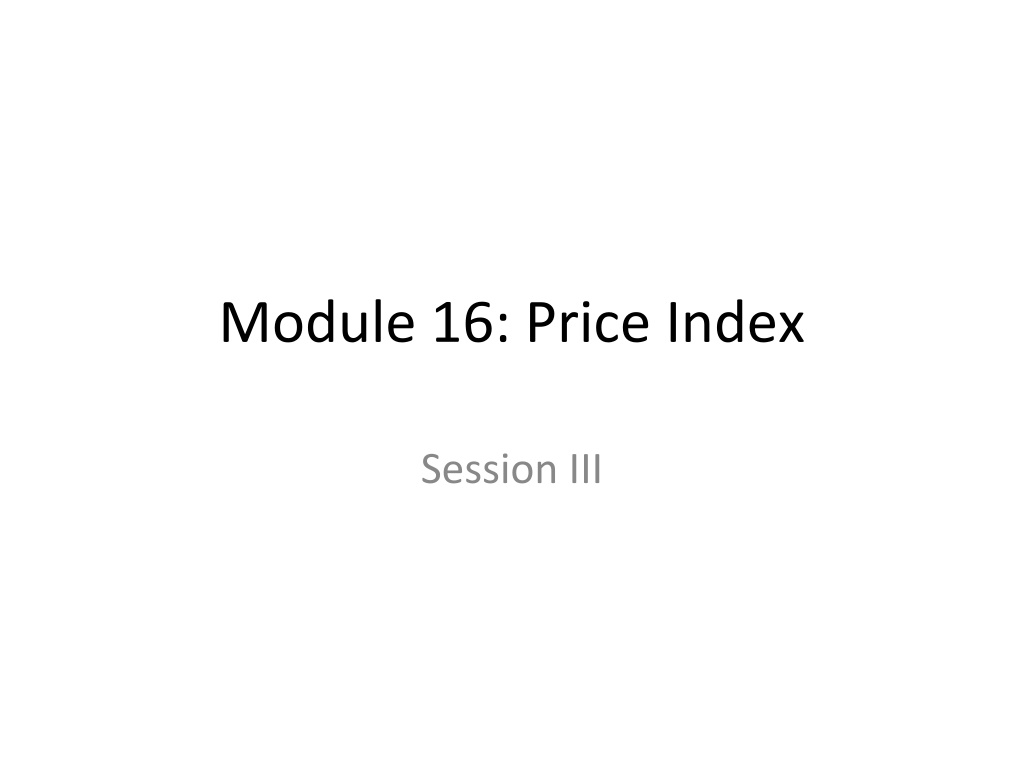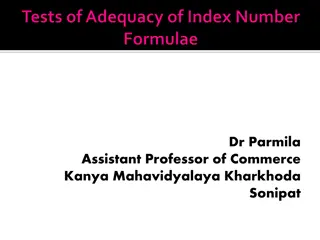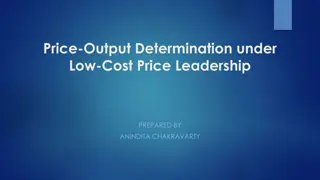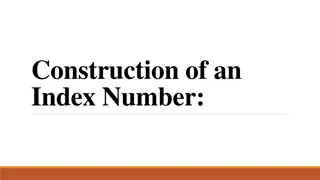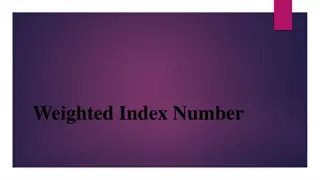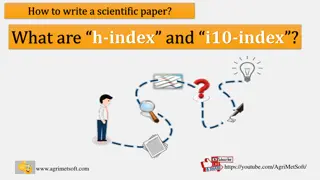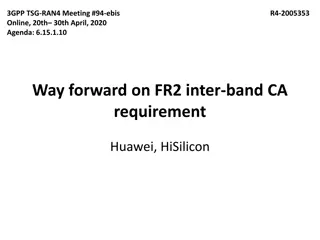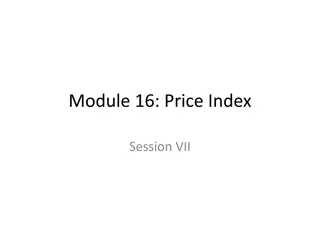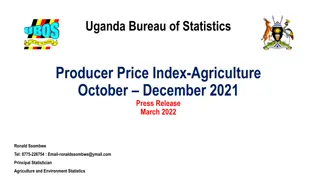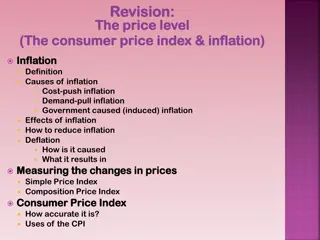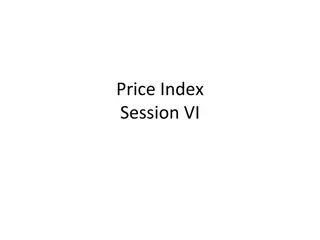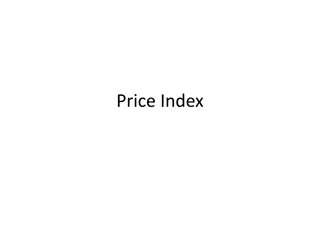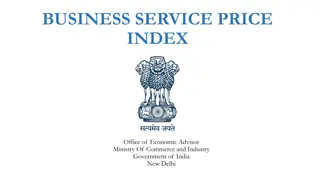Understanding Price Index Formulas and Aggregation Methods
Exploring the significance of price index formulas and aggregation methods in economic analysis. Learn about simple and weighted aggregate indices, elementary index calculations, and why aggregation methods are essential for computing price changes accurately.
Download Presentation

Please find below an Image/Link to download the presentation.
The content on the website is provided AS IS for your information and personal use only. It may not be sold, licensed, or shared on other websites without obtaining consent from the author. Download presentation by click this link. If you encounter any issues during the download, it is possible that the publisher has removed the file from their server.
E N D
Presentation Transcript
Module 16: Price Index Session III
Contents Session III Index number formula Simple index: Dutot, Carli and Jevon Weighted index: Lowe, Laspeyres, Paashe s and Fischer s 2
Price Index Formula Index number formula Recall that there are three types of indices Simple index number or elementary index Simple aggregate index Weighted aggregate index. Elementary index simplest type is defined as ?????0 ???= for the ith product between the base period and the current period.
Price Index Formula Why we need an aggregation method? A price relative is computed for a single commodity. For an exactly-specified commodity, price relatives measure pure price change. But for a consumption item, consisting of different varieties with varying price, we cannot compute its price relative. For example, rice with different varieties coarse, medium and fine. We can define a derived price of the item rice as total value/total quantity the value of ratio derived prices of two time periods will be affected by both the change in composition as well as change in prices. It is not a measure of pure price change.
Price Index Formula Aggregation methods broad kinds Depending upon whether the aggregation method uses weight for the commodities or commodity-groups involved, we have two broad kinds of aggregate index, viz.: Simple aggregate index based on unweighted aggregation Weighted aggregate index based on weighted aggregation.
Price Index Formula Simple aggregate index A simple aggregate index is calculated from individual price observations without using weights. Three most commonly used simple(unweighted) aggregate index formulas are: Dutot Carli and Jevon These are used for compiling elementary price indices from observed price data. 7
Price Index Formula Simple aggregate index Dutot In this method, the aggregate price of various commodities in a given year is expressed as a percentage of the same in the base year. The formula is P0t= pt/ p0 * 100 - where pt= aggregate of prices for the current period. - and p0= aggregate of prices for the base period. [henceforth the subscript i for products is dropped from the formula. All the signs represent sum over all products.] 8
Price Index Formula simple aggregate Example 10: Simple Aggregate Index (Dutot index) Definition: Ratio of simple aggregate price in current period to simple aggregate price in base period, i.e. ?? ?0 A family weekly diet in July 2005 and 2010 July 2005 July 2010 Item Price p0 Quantity q0 Price p1 Quantity q1 Fish Beef Pork Chicken Sum of Prices for all items 5.5 10.0 7.0 5.0 2.0 6.0 0.0 0.0 6.0 11.0 7.0 5.8 1.0 3.0 1.0 3.0 27.5 29.8 Calculate Dutot Index in your workbook 1.084 1.084 =29.8/27.5 Simple aggregate index Simple aggregate index 9
Price Index Formula simple aggregate Limitations of Dutot Index This Dutot Index is simple but has the following limitations: i. The prices of various commodities may be quoted in different units, - e.g., price of cereals may be quoted in Yen per quintal, liquids like milk, petrol, kerosene may be quoted in Yen per liter; cloth may be quoted in Yen per meter and so on. - Thus, the index is influenced very much by the units in which commodities are quoted and accordingly some of the commodities may get more than their due importance. 10
Price Index Formula simple aggregate Limitations of Dutot Index (contd.) - (ii) according to the magnitudes of their prices In this method the commodities get weighted - Thus highly priced commodities exert greater influence on the value of the index. - (iii) The relative importance in use of various commodities is not taken into consideration. 11
Price Index Formula simple aggregate Simple Aggregate Index - Carli Carli price index is defined as the unweighted arithmetic average of the current to base period price relatives. That is, Carli Price index = 1 ? ??? ?0? It is used to obtain elementary index. 12
Price Index Formula simple aggregate Example 11: Carli index a simple aggregative formula Definition: Simple arithmetic mean of price relatives of n commodities for current period, i.e. 1 ? ?? ?0 A family weekly diet in July 2005 and 2010 July 2005 July 2010 Item Price relatives Price relatives Price p0 Quantity q0 Price p1 Quantity q1 Fish Beef Pork Chicken 5.5 10.0 7.0 5.0 2.0 6.0 0.0 0.0 6.0 11.0 7.0 5.8 1.0 3.0 1.0 3.0 1.091 1.100 1.000 1.160 1.088 1.088 Calculate Carli Index in your workbook Simple arithmetic Simple arithmetic mean of price mean of price relatives for all relatives for all items items 13
Price Index Formula simple aggregate CarliIndex - advantages and limitations Carli price index gives equal weights to all the items. By economic approach, it has an upward bias. When the items should be given equal weights and their prices vary randomly in a given period, Carli index is the best measure for common inflation rate. 14
Price Index Formula simple aggregate Example 12: Jevons index- another simple aggregative method Definition: Simple geometric mean of price relatives for current period, i.e. ?? 1? ?0 A family weekly diet in July 2005 and 2010 July 2005 July 2010 Item Price relatives Price relatives Calculate Jevon Index in your workbook Price p0 Quantity q0 Price p1 Quantity q1 Fish Beef Pork Chicken 5.5 10.0 7.0 5.0 2.0 6.0 0.0 0.0 6.0 11.0 7.0 5.8 1.0 3.0 1.0 3.0 1.091 1.100 1.000 1.160 1.086 1.086 Simple geometric Simple geometric mean of price mean of price relatives for all items relatives for all items 15
Price Index Formula weighted aggregate Weighted Aggregative Method: In this method, appropriate weights are assigned to various commodities to reflect their relative importance in the group. Usually the value of quantities consumed, sold or marketed in the base year or in a given year are used as weights. If vi is the weight attached to a commodity then the weighted price index is given by P0t=( pitvi/ pi0vi) * 100 This called the Lowe Index. 16
Price Index Formula weighted aggregate Lowe Index - defined If the weights vi in the above formula be the quantities of a period b, different from both the periods 0 and t, the index takes the following form ????.??? ???0.??? ?0?= 100 This can be written as ??? ??0.?? ??0??? ???0??? (?) (?)= ?0?=100 ? ?? where Lowe Price Index is a weighted arithmetic average of the price relatives, with the ith item-share in total expenditure in period b as the weights often called hybrid weights. 17
Price Index Formula weighted aggregate Lowe Index There are many ways in which these weights (vi) which are not necessarily reference quantities might be specified. For a Lowe price index, these weights are fixed and predetermined, but need not pertain to either quantity or expenditure of the time period for which prices are being compared. By use of different types of weights, a number of formulae emerge for the construction of price index numbers. 18
Price Index Formula weighted aggregate Types of Weights an example A family weekly diet in July 2005 and 2010 July 2005 July 2010 Item Price p0 Quantity q0 Value Value p0q0 p0q0 weight weight w0 w0 0.155 0.155 0.845 0.845 0.000 0.000 0.000 0.000 1.000 1.000 Price p1 Quantity q1 Value Value p1q1 p1q1 weight weight w1 w1 0.095 0.095 0.521 0.521 0.110 0.110 0.274 0.274 1.000 1.000 Fish Beef Pork Chicken Total 5.5 10.0 7.0 5.0 2.0 6.0 0.0 0.0 11.0 60.0 0.0 0.0 71.0 6.0 11.0 7.0 5.8 1.0 3.0 1.0 3.0 6.0 33.0 7.0 17.4 63.4 Value/ expenditure weight in base period Value/ expenditure weight in current period Quantity weight in current period Quantity weight in base period 19
Price Index Formula weighted aggregate Laspeyres Price Index Laspeyres Price Index is obtained by replacing vi in the Lowe formula by q i0 the base year quantity ??????0 ???0??0 This reduces to ??? ??0. ??= 100 ??0??0 ???0??0= 100 ? ??? ??0.??0 ??= 100 ? ??0??0 ???0??0 where ??0= Laspeyres Price Index is a weighted arithmetic average of the price relatives, with base period ith item-share in total expenditure as the weights (wi0). 20
Price Index Formula weighted aggregate Example 13: Laspeyres price index A family weekly diet in July 2005 and 2010 July 2005 July 2010 Item p0q0 p1q0 Price p0 Quantity q0 Price p1 Quantity q1 Fish Beef Pork Chicken Total 5.5 10.0 7.0 5.0 2.0 6.0 0.0 0.0 6.0 11.0 7.0 5.8 1.0 3.0 1.0 3.0 11.0 60.0 0.0 0.0 71.0 in your workbook 12.0 66.0 0.0 0.0 78.0 1.099 1.099 Calculate these values Laspeyres' Laspeyres' price index price index Using quantity weight q0 in base period, Lp = 100*(weighted aggregate price in current period) / (weighted aggregate price in base period) = 109.9 21
Price Index Formula weighted aggregate Example 13: Laspeyres price index (contd.) A family weekly diet in July 2005 and 2010 July 2005 July 2010 Item p1/p0 (p1/p0)w0 Price p0 Quantity q0 weight weight w0 w0 0.155 0.155 0.845 0.845 0.000 0.000 0.000 0.000 1.000 1.000 Price p1 Quanty q1 Fish Beef Pork Chicken Total 5.5 10.0 7.0 5.0 2.0 6.0 0.0 0.0 6.0 11.0 7.0 5.8 1.0 3.0 1.0 3.0 1.091 1.100 1.000 1.160 0.169 0.930 0.000 0.000 1.099 1.099 Calculate these values in your workbook Calculate weights Laspeyres' Laspeyres' price index price index weights price relatives Lp = 100*(weighted arithmetic mean of price relatives) 22
Price Index Formula weighted aggregate Paasche s Price Index Paasche s Price Index is obtained by replacing W in the above equation by q 1 the current year quantity t q p 0 p q t t = P P 1 1 1 1 p P p q P p = = = 0 0 t t t P w w P t t P q P p 0 t t t t where, p p q = t t w t q t t Paasche s Price Index is a harmonic (not arithmetic) average of price relatives with current period weights of expenditure. 23
Price Index Formula weighted aggregate Paasche s Price Index Paasche s Price Index is obtained by replacing vi in the above equation by qit the current year quantity ??????? ???0??? ??= 100 Paasche formula can be expressed in two alternative ways: A. As weighted arithmetic average of price relatives, using ??0??? ???0??? ??= hybrid weights: B. As weighted harmonic average of price relatives, using ?????? ??????? ???= current period weights in: 24
Price Index Formula weighted aggregate Example 14 : Paasche s Price Index A family weekly diet in July 2005 and 2010 July 2005 July 2010 Item p0q1 p0q1 p1q1 p1q1 Price p0 Quantity q0 Price p1 Quantity q1 Fish Beef Pork Chicken Total 5.5 10.0 7.0 5.0 2.0 6.0 0.0 0.0 6.0 11.0 7.0 5.8 1.0 3.0 1.0 3.0 5.5 30.0 7.0 15.0 57.5 workbook 6.0 33.0 7.0 17.4 63.4 1.103 1.103 Calculate these values in your Paasche's Paasche's price index price index Using quantity weight qt in the current period, Pp = 100*(weighted aggregate price in current period) / (weighted aggregate price in base period) = 110.3 25
Price Index Formula weighted aggregate Example 14 : Paasche s Price Index (contd.) A family weekly diet in July 2005 and 2010 July 2005 July 2010 (p1/p0) (p1/p0)-1 -1w1 w1 Item p1/p0 Price p0 Quantity q0 Price p1 Quanty q1 weight weight w1 w1 Fish Beef Pork Chicken Total 5.5 10.0 7.0 5.0 2.0 6.0 0.0 0.0 6.0 11.0 7.0 5.8 1.0 3.0 1.0 3.0 0.1 0.1 0.5 0.5 0.1 0.1 0.3 0.3 1.0 1.0 1.091 1.100 1.000 1.160 values in your workbook 0.087 0.473 0.110 0.237 0.907 Sum 1.103 1.103 Inverse Paasche's Paasche's price index price index Calculate weights Calculate these weights price relatives Pp = 100*(weighted harmonic mean of price relatives) 26
Price Index Formula weighted aggregate Laspeyeres vs. Paasche Points to note about Laspeyeres and Paasche s methods: Laspeyres method is that it is generally expected to overestimate or to leave an upward bias. Paasche s method to underestimate, i.e., show a downward bias. But the above arguments do not imply that Laspeyres index must necessarily be larger than the Paasche s. 27
Price Index Formula weighted aggregate Fisher s Index Fisher Price Index is defined as the geometric mean of Laspeyres and Paasche s indices. Symbolically, FP01=( LaP01 * PaP01)1/2 =( p1q0/ p0q0 * p1q1/ p0q1)1/2 *100 For example, if LP= 100*1.099 = 109.9 PP= 100*1.103 = 110.3 then FP= 100* SQRT(1.099 1.103)=110.1 28
Price Index Formula weighted aggregate Fisher as Ideal index Fisher s Price Index number is known as Ideal due to the following reasons:- - (i) It is free from bias, since the upward bias of Laspeyres index number is balanced to a great extent by the downward bias of Paasche s index number. - (ii) It is based on the geometric mean, theoretically which is considered to be the best average for constructing index numbers. - (iii) It conforms to certain tests of consistency. - (iv) This formula takes into account the influence of the current as well as the base year. 29
